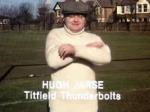There's a reference to a game taking place between St. Matthias's and All Saints "on the Meadow Lane ground", reported on Monday 8th February 1886. St Matthias was a church in Sneinton. All Saints also played a home game there soon afterwards.
First reference to Rangers playing there that I can see is Thursday 07 October 1886. A few days later... "Clay started the ball for the Meadow-lane end, and immediately the Rangers were conceded corner" and the Monday report "This match was played on Saturday on the Rangers' new ground, in Meadow-lane, before thin attendance of spectators." Another reference in 1887 says " The visitors won the toss, and the ball was set rolling 3.30, the home team kicking towards Trent goal" so from that we get the idea that the pitch was not parallel to the road and, as the other goal is decribed as the "Meadow Lane end" it seems safe to presume that the ground was on the eastern side of the road.
Rangers' demise in May 1890 coincided with Forest moving to the Town Ground in October 1890, which was close to Meadow Lane in the Meadows, so it's possible that the majority of the Rangers support (which was over 1,000 for one of their final games) then began watching the reds rather than Notts, who would presumably have been considered as more of a rival club, being then based at Trent Bridge. You've literally got Notts as the West Bridgford club and Fword as the Meadows outfit for a decade. All of this moving about did nothing to encourage clearly defined rival catchment areas, which hasn't helped Notts in the long run.
After May 1890, the ground continues to be in use, Sneinton Institute Wanderers v St. Andrews Institute in January 1891, a few months later "Radcliffe and Trent Wanderers meet Good Friday Meadow-lane Ground", also reference to Grove Swift playing there but mostly Sneinton Institute. Last reference to the ground I can see is 1893.








 Reply With Quote
Reply With Quote